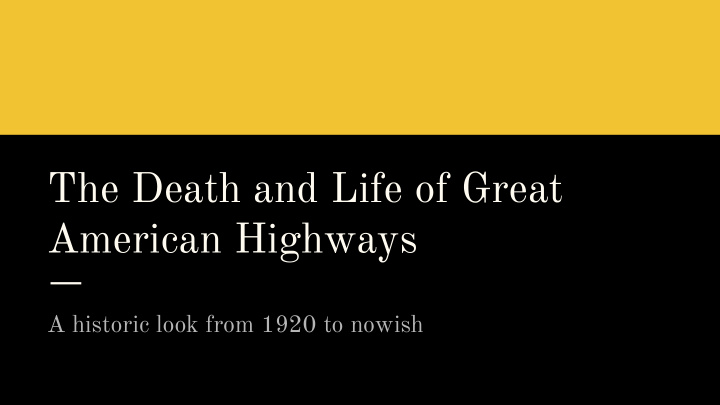



The Death and Life of Great American Highways A historic look from 1920 to nowish
1: Futurama
It’s the 1930s ● Great depression - not good ● Pinball was just invented - also not good ● You’re looking for some inspiration and hope ● You buy a ticket to the 1939 World’s Fair in NYC
Futurama (1939 World’s Fair) ● A 1 acre interactive exhibit featuring transportation of the future ○ Higher driving speeds ○ Partitions of isolated traffic moving both ways ● Predicts a bold increase of automobiles for the next 20 years ● Sponsored by Shell and General Motors ● Voted most interesting exhibit by fairgoers
Dwight D. Eisenhower ● US President 1953 - 1961 ● A big fan of highways ● 1919 Transcontinental motor convoy ○ DC - San Francisco trip, took 2 months ○ Painful, with many breakdowns ● Inspired by the autobahn while fighting in WW2
Dwight D. Eisenhower ● Quote from his book: ○ "The old convoy had started me thinking about good, two-lane highways, but Germany had made me see the wisdom of broader ribbons across the land."
Dwight D. Eisenhower ● Signs the Federal Aid Highway Act of 1956 ○ $25 billion over 10 years for highway construction ● Cold War also big motivator ○ Moving across country from 2 months to 5 days
Suburbia in USA, 1960s onwards ● Economic boom: housing and automobile growth ● Highways that run right into the city ○ “We don’t have to live in the city anymore!” ■ Avoid crime in cities ■ Own land, front yard
Suburbia in USA, 1960s onwards
Urban sprawl (Los Angeles)
2: Highways go up!
It’s the 1950s, and people need highways. ● You’ve got this great national interstate highway. ● You want to connect it right into the core of your city. ● But….there’s no space ● How are you going to make it happen?
A: Follow a convenient no-construction area (river)
B: Build across the waterfront
Or even two!
C: Try to build it through pre-constructed areas? ● Tear down the buildings on a stretch of land ● Build a highway! ● They won’t mind right?
Moses vs Jacobs ● Famous 1950s highway dispute: Lower Manhattan Expressway ● Robert Moses, “master builder” and Jane Jacobs, local resident
Jane Jacobs ● After successfully defending NYC, she became a hero ● Goes on to write the bible of planning, 1961 ● Moves to Toronto in 1968, influential in highway revolts
Highway revolts across America (1960s - 70s) ● In other cities, residents gathered to protest highways
D: The other way ● Build through a politically weak neighborhood
Hogan’s Alley ● Predominantly African immigrant neighborhood in Strathcona ● Destroyed in the 1970s for the Georgia Viaduct
3: Highways go down
Why are highways bad?
Why are highways bad? ● Nobody wants to be around them ○ They are borders, they sever communities ● Bad for land value, environmentally bad ● Studies have shown they increase congestion in surrounded areas ○ Bigger streets ≠ lower traffic ● Expensive, harder to maintain than roads ○ Funding to build highways was high. Funding to maintain them is low.
Why are highways bad? ● General Theory of Walkability ● A quality walk: ○ Useful : Convenient, accessible ○ Safe : from high speed vehicles ○ Comfortable : tight better than vast ○ Interesting : signs of humanity ● Which of these come with highways?
Why are highways bad?
Case Study: San Francisco Embarcadero 1989
1989 Loma Prieta earthquake ● Santa Cruz/San Francisco ● During 1989 World Series Game 3 (which apparently saved lives) ● 63 killed, $6 billion in damage ● The embarcadero freeway collapses ○ Local government choose not to reconstruct
A happy accident: Wait, that worked? ● Other cities take notice ○ Seattle ○ Boston ○ Seoul ○ Toronto (we’re still working on that one) ○ Many more: HIghway Hitlist
Thanks y’all ● Videos ○ About Here (Youtube) ○ Vox ● Reading ○ The Death and Life of Great American Cities ○ Walkable City ○ r/urbanplanning
Recommend
More recommend